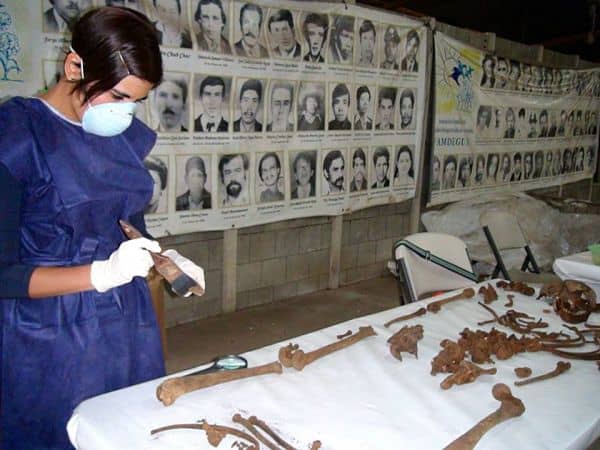I arrived to La Ciudad Cemetery by the end of February 2014 as part of an introductory training on Forensic Anthropology. In the picture above, the remains in front of me are those of an unidentified sub-adult whose cause of death was categorized as ‘undetermined’. The black and white posters that hang behind me correspond to the faces of numberless of individuals that seek to draw attention to the forty five thousand detained-disappeared in the aftermath of the Guatemalan internal conflict (1960-1996). While I am carefully cleaning the set of bones lying on my table, I remember the instructor explaining how to record and categorize physical trauma. The anthropological analysis would deal with the estimation of age, sex determination, statute, possible skeletal anomalies, pre mortem fractures and possible peri-mortem trauma. A finalized forensic report highlights patterns to allow inferences about the manner of death and the cause of death that aim to provide with “reasonable degree of certainty” the likelihood of an event – this is to say, what really happened. [i]
 A ‘body’ is constructed as forensic evidence by a temporal and spatial process in which a sum of human materials that bear certain acts of injury and disease are sequentially decoded to infer an episode of killing [ii] – these ‘objects of death’ in themselves are not evidence – they become evidence in the context of an enquiry [iii]. The bones and other found objects are not regarded in isolation but transverse in fields of relations from which [assemblies of connections] are made [iv] where
A ‘body’ is constructed as forensic evidence by a temporal and spatial process in which a sum of human materials that bear certain acts of injury and disease are sequentially decoded to infer an episode of killing [ii] – these ‘objects of death’ in themselves are not evidence – they become evidence in the context of an enquiry [iii]. The bones and other found objects are not regarded in isolation but transverse in fields of relations from which [assemblies of connections] are made [iv] where
“We, The (sic) forensics help out to rebuild a story but we do not tell it alone … We contribute to solve a part of a story and in great part to recover the memory.”[v]
Exhumations in la Ciudad resulted in more than sixteen thousand bodies and body parts exhumed from their ossuaries and stored in plastic bags. Each of these bags contains hundreds of skeletal remains and /or a complete skeleton. When the exhumations in Guatemala started in 1988 these were initially aiming at the identification of victims of massacres and circumscribed to rural areas, but pressure from relatives of the disappeared ones in the cities soon demanded a search extended to urban places. In Guatemala City, it was discovered that public cemeteries were used for the disposal of bodies that were dumped into deep ossuaries where their unidentified corpses were labelled in the public records as ‘NN’. [vi]

In January 2010, a forensic anthropological team formed the non-identified persons investigation unit and began with landmark exhumations of the ossuaries in different public cemeteries. According to their leaflet and different media-reports advertising the exhumations, the objective of the recovery of the remains was the identification of persons through the correlation between the data of the unidentified ‘NN’ of the graveyards with the information of the reports of disappeared individuals. As such, the campaign in La Ciudad was widely framed and perceived as aiding justice through producing truth for the families of the victims. The inauguration ceremony took place one month afterwards and attracted wide media attention and the participation of victim’s organizations, local politicians and diplomatic representatives of foreign delegations. The speeches of the ceremony situated the remains in a constant constitution and negotiation of their substance “as persons or things, subjects or objects, meanings or matter” [vii]– “In order to heal we need to know the truth! Because justice is based on the truth.” [viii]
When the remains are recovered, every single piece of bone whether it belongs to a complete or incomplete skeleton is labelled with a specific code number, compiled, tagged and stored for future analysis and cause of death. The correlation between human remains and that of forensic classification implies the removing of personhood and identity from remains to be classify leaving space only for the enumeration of the physical characteristics. [ix] This classification however, requires a process of reduction where questions of violence are translated and disguised into methodologies and techniques that validate the scientific process (as for example bone DNA) ultimately as the explanans. [x] To that extent, complex political and structural problems that resulted in a killing event are framed into a system of codification that would invariably dangle on the possibility of the scientific translation.

As an instructor explained to me,
when the remains show signals of peri-mortem trauma in the skull, these are labelled as “A” and sent directly to the DNA laboratory to processing and genetic profile determination. When the injuries are not consequential to gunshot but are still found in the skull – the remains would get priority “B” and DNA analysis is then optional. If the injuries are not in the skull or there are no peri-mortem injuries at all, there is a strong probability that the remains will never get a genetic profile and will be merely returned to the ossuaries.
In spite of the narrative surrounding the exhumations, five years after the starting of the project only seven forced disappeared victims have been positively identified. The forensic sensibility can pierce together a truth because
“the bones can speak and tell a story” [xi]
– but what is the faith of those ‘bodies’ who cannot “talk” with regard to the objectives aimed by transitional justice narratives? In the context of La Ciudad, the skeletal remains that do not fall within “A” or “B” categories would continue with the marker ‘NN’ and be left aside [together with thousands other bodies] from the promise of justice and reconciliation.
Perhaps these ‘NN’ are a source of resistance – so to say – to any imaginary of transition, since the allocation of violence that the transitional stage seeks to ‘lock’ in the past cannot be left behind [xii] but stands timeless and critical without a voice to be decoded, but with a voice nonetheless.
Foot notes
[i] Erin. H. Klimmerle, et al., (ed). Skeletal Trauma. Identification of Injuries Resulting from Human Rights Abuse and Armed Conflict. CRC Press, (2008), p. 11.
[ii] Layla Renshaw. Exhuming Loss: Memory, Materiality and Mass Graves of the Spanish Civil War. Left Coast Press (2011), pp. 121-151.
[iii] Matthew Engelke. The Objects of Evidence. Anthropological Approaches to the production of knowledge. Wiley-Blackwell (2009), pp. 1-7.
[iv] Eyal Weizman (ed). Forensis. The Architecture of public truth. Sternberg Press, (2014). Introduction.
[v] Statement by JP in a public interview, 2008.
[vi] NN stands for ‘no name’ or a body without identification.
[vii] Cara Krmpotich, et al., The Substance of Bones. The Emotive and Affective Presence of Human Remains 15 Journal of Material Culture (2010): 371- 384, p. 372.
[viii] Statement by victim’s relative during the inauguration ceremony.
[ix] Layla Renshaw. Exhuming Loss: Memory, Materiality and Mass Graves of the Spanish Civil War. Left Coast Press (2011), p.p. 121-146.
[x] Yuri Pascacio Montijo. On the objective character ascribed to bones. Paper presented for the European Association for Social Anthropology Biennal Conference in Tallin, Estonia. 31 July- August 3, 2014.
[xi] Clyde Snow. Inaugural lecture at the Master of Forensics Sciences in San Carlos University, Guatemala City, February 2013.
[xii] Alejandro Castillejo-Cuellar. https://allegralaboratory.net/on-harm-and-history/
Gratitudes to the Rechtskulturen Program for the funding provided for this fieldwork and to DJG for his contribution in the field. All names have been changed.





